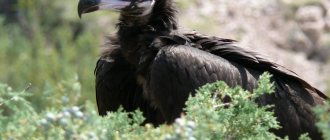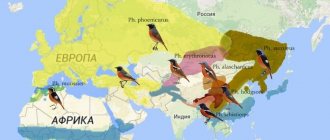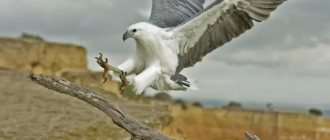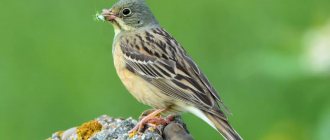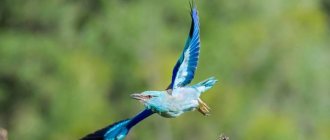- Wild animals
- >>
- Birds
The moskovka or black tit, the moskovka is one of the smallest birds living in Russia. The weight of this bird is only 7-10 grams, body length is about 12 centimeters. A very nimble, active bird that sometimes inhabits the coniferous forests of our country and is sometimes found in forest plantations and parks. Does not like to settle in populated areas, but can fly to feeders in search of food. In winter, they can live in whole flocks in parks and squares.
Origin of the species and description
Photo: Moskovka
Periparus ater The Muscovy is a bird belonging to the order Passeriformes, the tit family, the genus Periparus, the Muscovite species. The Moskovka belongs to the oldest order of passerine birds. The first passerines inhabited our planet back in the Eocene. Nowadays, the order of passerines is extremely numerous; it includes about 5,400 species.
These birds are widespread throughout the world. The species Periparus ater in our region is represented by 3 subspecies, two of which are included in the group of subspecies “phaeonotus”; these birds are distributed mainly in Turkey, the Middle East and the Caucasus. In the European part of our country, the subspecies R. a. ater.
Video: Moskovka
Muscovites are small, modestly colored birds. Females and males have the same color, sometimes the color of males can be a little brighter than that of females. On the bird’s face there is a kind of dark-colored “mask”, which is why the birds got their name. The upper part of the head is painted blue-silver with an olive tint, the underside of the bird is light.
There are brown feathers on the sides and undertail. From the line of the eyes to the throat and top of the breast, the color is white. There are small black spots on the chest, sides and under the wings. The wings and tail of the bird have a brownish tint. The beak is small and black. The head is round, the eyes are small, the iris of the eyes is dark. The limbs have four fingers, with claws at the ends. This species was first described by the scientist Carl Linnaeus in his work “System of Nature” in 1758.
What does a titmouse eat in the wild in summer and winter?
Tits are insectivorous birds and feed on the following insects:
- Invertebrates and their larvae
- Caterpillars of various butterflies, dragonflies
- Spiders, beetles, including weevils
- Midges, flies, mosquitoes
- The titmouse is not averse to eating aphids
- Ants and bees can also make up a bird's diet.
- With pincers
- Sometimes a tit can eat cockroaches and grasshoppers
This is the diet of the titmouse mainly in the summer. In the spring, some species of tits can hunt dwarf pipistrelles that have not awakened from hibernation.
What do titmouses eat?
Starting in autumn and including winter, birds begin to eat mainly the following food:
- Hazel
- Grain of corn, wheat, oats
- Pine and linden seeds
- Fruits of lilac, rowan, blueberry, sunflower
- Sometimes they can diversify their diet with carrion
It must be said that such species of tits as blue tits and black tits take care of their food in the fall and stock up on the necessary products - seeds, grains. Other species of tits most often feed on other people's reserves, which they are very good at finding.
Appearance and features
Photo: What a Moscow woman looks like
The Muscovy is very similar to ordinary tits, but Muscovites are still slightly different from other representatives of this family. These creatures are considered the smallest birds from the tit family. The size of the bird from beak to tail is about 11 cm, and the Muscovy weighs only 8-12 grams.
The beak is straight and small in size. The head is small and round in shape. A distinctive feature of these birds is their unusual coloring. The bird’s face has white “cheeks”. From the beak to the entire head the color is dark. It seems as if there is a “mask” on the bird’s face, which is why the bird got its name.
When the Muscovy is excited, it raises the feathers on its forehead in the form of a small tuft. There is also a white spot on the top of the bird's head. The main color is gray and brown. The feathers on the head are black with a silver-blue tint. The feathers on the wings of the Muscovy are gray and have patterns in the form of white stripes. The tail consists of a bunch of flight feathers.
Males and females are practically indistinguishable in appearance. Juveniles have a color similar to adult birds. A dark blue, almost black cap with a brownish tint; on the cheeks at the back of the head, where there should be white spots, the color is yellowish. The stripes on the wings also have a yellowish tint.
The trills of these birds can be heard everywhere from mid-March to September. The Muscovite singing is quiet and their voice is squeaky. The song consists of two or three syllable phrases like: “teweeit”, “pii-tii” or “Si-Si-Si”. Females and males sing together. One bird can have up to 70 songs in its repertoire. Sometimes tits are used to teach canary birds to sing. In the wild, mossbirds live for about 8-9 years.
Interesting fact: Muscovites have excellent memory; they can remember places where food is located, people who feed the birds, and most importantly, after a long stay in unfamiliar places, these birds can find their nest and the places where they hid food.
Now you know what the Muscovy bird looks like. Let's see where the black tit lives.
Interesting facts about titmice: examples
Despite the fact that titmice live very close to people, we know very little, if not nothing, about them. Therefore, we invite you to familiarize yourself with the most interesting facts about these birds.
- Tits have long been considered incredibly useful birds for humans, so even in Rus' a decree was issued stating that for the extermination of tits, a person will face severe punishment in the form of a fine.
- Despite the fact that in our area the most common is only 1 species of tit, the great tit, there are about 65 species in nature.
- Many people think that the bird got its name because of the blue color of its plumage, but tits rarely have this color in color and this is surprising. However, in fact, the titmouse got its name because of the sounds it makes; if you listen closely, you can hear “si-sin-si,” hence the tit
Tits: interesting facts
- During the period of feeding the chicks, the tit gives them food about 35 times per hour
- Most tits are excellent flyers, despite the fact that they flap their wings very rarely, they fly very quickly and briskly
- Tits are very sociable birds and can be tamed if desired.
- Almost all tits build nests in hollowed-out hollows, since they themselves do not know how to do this
Tits are incredibly beautiful and useful birds for humans and nature, which is why we must make every effort to ensure that they are comfortable in the winter and that they are not hungry.
Where does the Muscovite live?
Photo: Moscow bird
Muscovites inhabit the forests of Eurasia and North Africa. Also found in the Atlas Mountains region, Africa and Tunisia. In the northern part of Eurasia, these birds can be found in Finland and in the Russian north, in Siberia. These birds inhabit the Kaluga, Tula, and Ryazan regions in large numbers, and live in the Urals and in the northern part of Mongolia. These birds also inhabit Syria, Lebanon, Turkey, the Caucasus, Iran, Crimea and Transcaucasia. Sometimes mosquitoes can be found on the island of Sicily, the British Isles, Cyprus, Honshu, Taiwan, and the Kuril Islands.
The Muscovite lives mainly in spruce forests. Sometimes a mixed forest can be chosen for living. If living in mountainous areas, nest on wooded slopes where pine and oak trees grow. Rarely settles at altitudes above 2000 meters above sea level, however, in the Himalayas, these birds are seen at an altitude of about 4500 m. Muscovites never sit still, and can explore new areas in search of food.
In places with a mild climate in the Caucasus and southern Russia, birds lead a sedentary lifestyle. These birds also often stay for the winter, moving to parks and squares in central Russia. Muscovites nest in the forest. These birds usually do not make seasonal migrations, however, in the absence of food or during a harsh winter, birds can make flock flights, exploring new territories.
Familiar places are usually used for nesting; in rare cases, they nest in new territories. The nest is made in a hollow or other natural cavity. Sometimes they can settle in an abandoned hole of small rodents. Due to the abundance of enemies in the wild, and the inability to fly long distances, Muscovites try to stay near trees and bushes.
What does a Muscovite eat?
Photo: Moskovka in Russia
Muscovy is very unpretentious when it comes to food. The bird's diet depends on the area in which the bird lives and the time of year. In spring and summer, birds eat more insects and plant foods; from mid-summer, birds switch to plant foods. In the winter season, Muscovites are content with seeds, rowan berries and what the birds have stored in the summer for the winter.
The basic diet of a Muscovite includes:
- Zhukov;
- caterpillars;
- aphids;
- silkworm;
- flies and mosquitoes;
- grasshoppers, crickets;
- arthropods;
- coniferous seeds;
- rowan berries, juniper;
- seeds of beech, sequoia, sycamore and other plants.
This bird also loves to eat juicy ripe fruits and nuts. Muscovites are excellent at climbing tree branches to get their food.
Interesting fact: Muscovites are very thrifty, and in the wild these birds work hard during the summer to stock up for the winter. The bird makes a kind of “pantry” under the bark of trees, where it hides its supplies, protecting them from the snow. Often these reserves last the bird throughout the winter.
Birds that live near human habitation fly to the feeders and peck bread crumbs, nuts, and seeds. Although these birds are afraid of people, they quickly get used to those who feed them, remember the place where the feeder is located and fly back again.
Nutrition
In spring and the first half of summer, birds actively feed on insects. Coleoptera, Hymenoptera, Reticulate, and Homoptera are included in the diet of these birds. This means that bark beetles, aphids, weevils and other beetles - all of which we consider forest pests - are actively eaten and fed to their offspring. Birds skillfully catch flies, butterflies and dragonflies.
From the second half of summer, Muscovites switch to vegetarian food. The input is the seeds of coniferous and deciduous trees. Tits are especially adept at processing pine and spruce cones. The menu can be diversified by berries, for example, juniper. Like many animals, birds hide everything they can eat in winter in hollows and cracks.
Snow and frost can drive birds out of the forest and towards people's homes. To villages and cities. Here everything becomes food, from the contents of feeders to food waste. Wintering in city parks and squares seems to be a habit of birds.
Features of character and lifestyle
Photo: Moskovka, aka black tit
Muscovites, like many tits, are very active. They constantly move between trees, crawling along branches in search of food. They lead a sedentary lifestyle, do not like to migrate and leave their usual habitats only in cases of lack of food or very bad weather conditions. Birds like to return to their usual places to nest.
Muscovites live in small flocks of 50-60 individuals, however, in Siberia and the conditions of the North, flocks of up to a thousand individuals have been recorded. Flocks are usually mixed, and Muscovites get along well with warblers, tufted tits, kinglets and pikas. During the nesting period, birds separate into pairs and build nests, populating a large area.
Tits are very good family men; they form pairs for almost their entire lives and care for their offspring for a long time. The birds have a calm character, the birds coexist peacefully within the flock, and there are usually no conflicts. Wild birds are afraid of people and try not to get close to people, however, in the winter season, harsh weather conditions force birds to move to cities and towns.
Birds quickly get used to people. If the Muscovy is kept in captivity, this bird very quickly gets used to humans. After only a week, the bird can begin to peck seeds from the owner’s hands, and over time, the bird can become completely tame. Tits are very trusting and easily get used to people.
How long does a tit live?: life expectancy in the wild and in a cage
Tits are very sociable birds, very often they live very close to our homes, which is why such a bird can often be seen in someone’s home, as a pet.
Despite the fact that the titmouse almost always perfectly adapts to new living conditions in the house, this bird, in principle, is not suitable for keeping at home - this is how nature has established it. It would seem, based on what has been said, that a tit in the wild lives a much longer life than a tit in captivity, but no, everything is completely different.
- In nature, that is, in the forest, a titmouse can live a very short life. The bird lives approximately from 1.5 to 3 years. 1 case was recorded when a tit lived about 10 years
- While at home, in warmth and care, a tit can live about 15 years
Social structure and reproduction
Photo: Moskovka tit
The mating season for Muscovite women begins at the end of March. During this period, males begin to attract females with loud singing, which is heard everywhere. They also notify other males about where their territory is, marking its boundaries. In addition to singing, males show their readiness to start a family by beautifully soaring in the air.
During the courtship dance, the male fluffs out his tail and wings, while continuing to sing loudly. Choosing a place for the nest is the responsibility of the male, but the female arranges the home. The female builds a nest inside a narrow hollow, in a rock crevice or in an abandoned rodent burrow. Soft moss, feathers, and scraps of animal fur are used to build the nest.
Interesting fact: Females are very protective of their young; while the eggs are incubating, the female does not leave the nest for about two weeks.
Muscovites manage to lay two clutches in one summer. The first clutch consists of 5-12 eggs and is formed in mid-April. The second clutch is formed in June and consists of 6-8 eggs. Muscovy eggs are white with brown speckles. Egg incubation lasts about two weeks. At the same time, the female incubates the eggs almost without leaving the clutch, and the male protects the family and obtains food for the female.
Small chicks are born covered with soft, gray down. The male brings food to the chicks, and the mother warms them and feeds them for another 4 days, and later begins to get food for the cubs together with the male, leaving the chicks in the nest. The chicks begin to fly away from the nest at the age of 22 days, and having learned to fly, the young can spend the night in the nest for some time, later the young chicks fly away from the nest, flocking with other birds.
Notes
- ↑ 1 2 Boehme R.L., Flint V.E.
Five-language dictionary of animal names. Birds. Latin, Russian, English, German, French / Under general. ed. acad. V. E. Sokolova. - M.: Russian language, RUSSO, 1994. - P. 367. - 2030 copies. — ISBN 5-200-00643-0. - ↑ Moskovka, tit // Encyclopedic Dictionary of Brockhaus and Efron: in 86 volumes (82 volumes and 4 additional). - St. Petersburg, 1890-1907.
- ↑ 1 2 3 A. S. Bogolyubov, O. V. Zhdanova, M. V. Kravchenko.
Moskovka // Guide to birds and bird nests in central Russia. — Ecosystem, 2006. - ↑ Killian Mullarney, Lars Svensson, Dan Zetterström, & Peter J. Grant.
Birds of Europe = Birds of Europe. - Paperback. - United States: Princeton University Press, 2000. - pp. 316-317. — 400 s. — ISBN 978-0-691-05054-6. - ↑ 1 2 3 4 5 6 7 8 9 10 11 Andrew Gosler, Peter Clement.
2007. Family Paridae (Tits and Chickadees). In del Hoyo J., Elliott A., Christie D., eds. Vol. 12. // Guide to the birds of the world = Handbook of the birds of the world. - Barcelona: Lynx Editions, 2007. - ISBN 84-96553-42-6. - ↑ 1 2 3 4 5 G. Dementyev, N. Gladkov.
Birds of the Soviet Union. - Soviet Science, 1953. - T. 5. - P. 744-749. — 797 p. - ↑ 1 2 3 E. A. Nazarenko, S. A. Bessonov.
Parus ater Linnaeus, 1758 - Moscow
(unspecified)
.
Vertebrates of Russia: a review
. Institute of the Russian Academy of Sciences named after. A. N. Severtsova. Access date: April 9, 2009. - ↑ 1 2 3 L. S. Stepanyan.
Abstract of the ornithological fauna of Russia and adjacent territories. - Moscow: Akademkniga, 2003. - 808 p. — ISBN 5-94628-093-7. - ↑ E. V. Rogacheva.
Birds of Central Siberia: distribution, numbers, zoogeography. - M.: Nauka, 1988. - 307 p. — ISBN 5-02-005252-3. - ↑ 1 2 A. V. Mikheev.
Biology of birds. Field guide to bird nests. - M.: Topikal, 1996. - 460 p. — ISBN 978-5-7657-0022-8. - ↑ Buturlin S.A.
Birds // Animal world of the USSR. - Moscow - Leningrad: Detizdat, 1940. - ↑ C. Linnaeus.
Systema naturae per regna tria naturae, secundum classes, ordines, genera, species, cum characteribus, differentiis, synonymis, locis. Tomus I. Editio decima, reformata. —Holmiae. (Laurentii Salvii), 1758. - P. 190. - ↑ Frank B. Gill, Beth Slikas, Frederick H. Sheldon.
Phylogeny of tits: II.
Relationships of species based on the sequence of mitochondrial cytochrome b (English) = Phylogeny of titmice (Paridae): II. Species relationships based on sequences of the mitochondrial cytochrome-b gene // American Ornithological Society. - The University of Notre Dame, 2005. - Vol. 122. (limited access)
Natural enemies of Muscovites
Photo: What a Moscow woman looks like
These little birds have a lot of natural enemies.
These include:
- birds of prey such as falcon, kite, hawk, eagle, owls and eagle owls;
- cats;
- martens;
- foxes and other predators.
Predators hunt both adult individuals and destroy nests by eating eggs and chicks, so these small birds try to stay together in flocks. Often the prey of predators are fledglings that are just beginning to learn to fly in a way that makes them most vulnerable. Muscovites do not like to appear in open areas, preferring to hide in trees and bushes. They feel safe there.
Birds' nests are destroyed by rodents, hedgehogs, martens, foxes and cats, so birds try to build nests in places inaccessible to these predators. They choose hollows and crevices with a narrow entrance so that predators do not get into them.
Most Muscovites die not from the clutches of predators, but from harsh environmental conditions. Birds do not tolerate cold well; in winter, wild birds often die of hunger without finding food, especially during snowy winters, when their reserves are covered with snow. To survive the winter, birds move to cities in small flocks. People can save many of these cute birds simply by hanging a bird feeder on a tree and bringing in some grains and bread crumbs.


